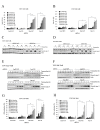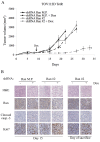An essential role for Ran GTPase in epithelial ovarian cancer cell survival
- PMID: 20942967
- PMCID: PMC2964620
- DOI: 10.1186/1476-4598-9-272
An essential role for Ran GTPase in epithelial ovarian cancer cell survival
Abstract
Background: We previously identified that Ran protein, a member of the Ras GTPase family, is highly expressed in high grade and high stage serous epithelial ovarian cancers, and that its overexpression is associated with a poor prognosis. Ran is known to contribute to both nucleocytoplasmic transport and cell cycle progression, but its role in ovarian cancer is not well defined.
Results: Using a lentivirus-based tetracycline-inducible shRNA approach, we show that downregulation of Ran expression in aggressive ovarian cancer cell lines affects cellular proliferation by inducing a caspase-3 associated apoptosis. Using a xenograft tumor assay, we demonstrate that depletion of Ran results in decreased tumorigenesis, and eventual tumor formation is associated with tumor cells that express Ran protein.
Conclusion: Our results suggest a role for Ran in ovarian cancer cell survival and tumorigenicity and suggest that this critical GTPase may be suitable as a therapeutic target.
Figures




References
-
- Ouellet V, Provencher DM, Maugard CM, Le Page C, Ren F, Lussier C, Novak J, Ge B, Hudson TJ, Tonin PN, Mes-Masson AM. Discrimination between serous low malignant potential and invasive epithelial ovarian tumors using molecular profiling. Oncogene. 2005;24:4672–4687. doi: 10.1038/sj.onc.1208214. - DOI - PubMed
Publication types
MeSH terms
Substances
Grants and funding
LinkOut - more resources
Full Text Sources
Other Literature Sources
Medical
Research Materials
Miscellaneous

